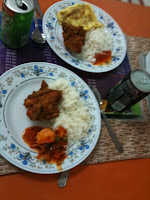These are comments linked to photos below.
Islamic Arts Museum and lunch
Well a fragile digestion saw me enjoying the smoothest and most luscious hummus and soft bread ever, and very limited quantities of an menu that won't annoy you all with. The big challenge for me was only to eat a very little of the roast lamb pieces, none of the salad, have a soupcon of cumin flavoured thin lentil soup, have only two spoons of a dessert that might have been made from eggs and nuts and even cream.
It's just not my usual style such restraint. But 'needs must' as they say, and interestingly the flavours were that much more intense! One of those obvious lessons of life I guess.
The Arts Museum itself was cool in all senses I think, wonderfully laid out, interesting materials linked to the other experiences of this trip - architecture, and the contribution of diverse cultures to daily life, science and maths, and general cultural practice.
The big news is that Grette found a little book about Islam and the spice trade which (not surprisingly) neatly describes the interlocking nature of the spread of Islam and the trade in spices. Also not surprisingly the European traders don't come out of it well, particularly their penchant for over exploitation of the resources.
while the Portuguese are acknowledged for plundering the East while they had the chance, comments on Trade from the West (thew Americas) pointed to Spain, and chocolate and Vanilla. I also know that the Spanish were big on cochineal, and kept the secret of its provinance hidden for a hundred years or so, in order to control the market.
So I realise why chillies, despite their incredible take up by just about every culinary disposition the world over, never rate a mention. Because there was no secret to keep, or limited supply from which access can be controlled. Those chilli seeds just grow like topsy. Not as invasive as blackberries, thankfully, or prickly pear (to ref back to cochineal for a moment), nor as limited in their setting as say chocolate, nutmeg or coffee. And a very easy germinator.
I see a series of films. Germinator 1 : the Chilli in Africa. Germinator 4 - Fire up the Danube!!
In the meantime, perhaps we can see that it's the limits of economic history (and military and colonial history) which explain the absence of chilibrations around the world, and why the contribution of the Portuguese is (understandably, perhaps) a little unappreciated.
Central Markets
And here was a very nourishing satisfying lunch for very little money, for two hot travellers, having the choice of about 8 or ten distinct authentic cuisines in a food court, surrounded by teenage local girls with mobile phones and fabric and soap and travel bag shops, in a 19th century market building.




























